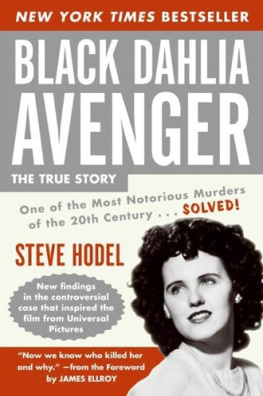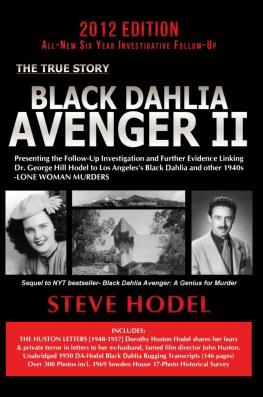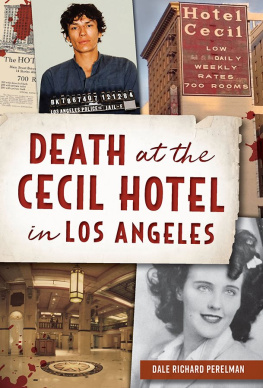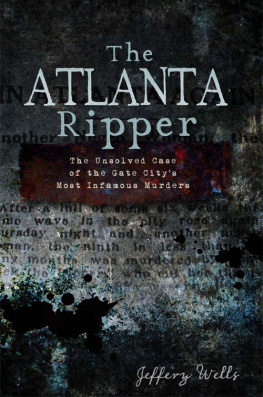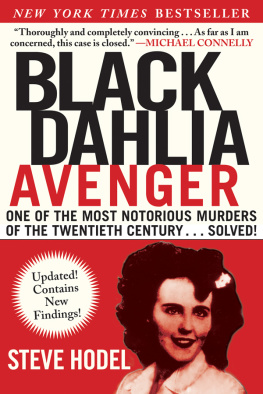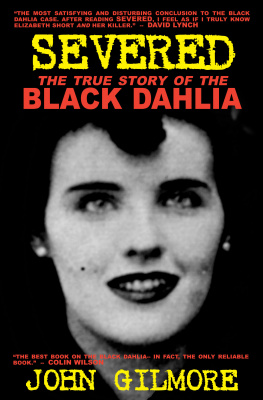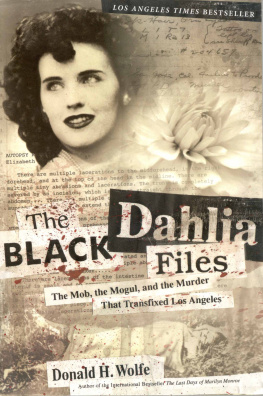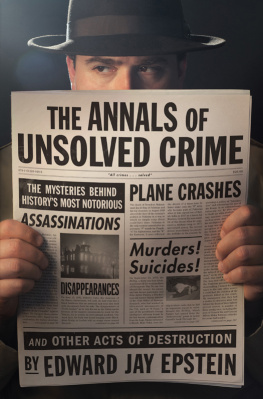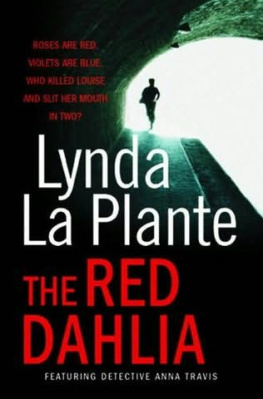FPT $27.95
$39.95 in Canada
In 1947 the brutal, sadistic murder of a beautiful young woman led to the largest manhunt in L.A. history. The killer teased and taunted the police and public, but his identity remained a mystery. Until now...
On January 15, 1947, at about 10:30 A.M., in Los Angeles, California, a woman's body was discovered in a vacant lot at 39th and Norton. Not only had the murderer bisected her but he had horribly mutilated her body, then carefully posed her as if to leave a provocative message. When LAPD detectives arrived on the scene a few minutes later, even the most hardened among them were shocked and sickened.
That crime, which until now has never been solved, became known to history as the Black Dahlia murder. It made front-page headlines coast-to-coast for weeks, as the LAPD sought vainly to track down the killer. The murdered girl, it turned out, was lovely twenty-two-year-old Elizabeth Short. From Massachusetts, she had come west, like so many women before her, in search of fame and fortune in the film capital of the world. Shortly after her murder, the L.A. papers began receiving notes from a person who called himself the Black Dahlia Avenger. For weeks the killer tormented police, clearly reveling in his notoriety and ability to avoid detection, much as his English counterpart Jack the Ripper had done in London sixty years before. At one point he offered to turn himself in, then reneged and said he was leaving town. "Catch me if you can," he challenged.
When the LAPD failed to solve the crime, the case was passed down from year to year to crack homicide detectives, but none could ever bring the killer to justice. In 1949, the Los Angeles grand juryconvened by the district attorney in the wake of public outcry against the failure of the LAPD to solve not only this crime but a dozen other murders of lone women in Los Angeles over the succeeding two yearsconducted their own investigation and subpoenaed LAPD detectives and the chief of police to testify. As a result, a "prime suspect" was identified and named in secret, but for some unexplained reason he was never indicted or brought to justice. Hints of LAPD corruption were rife during that era, and some very high-ranking police department heads rolled, as politicians vied to capitalize on the situation to their advantage.
04032745 (continued on back flap)
BLACK
DAHLIA
AVENGER
BLACK
DAHLIA
AVENGER
A Genius for Murder
STEVE HODEL

ARCADE PUBLISHING NEW YORK
Copyright 2003 by Steve Hodel
All rights reserved. No part of this book may be reproduced in any form or by any electronic or mechanical means, including information storage and retrieval systems, without permission in writing from the publisher, except by a reviewer who may quote brief passages in a review.
FIRST EDITION
ISBN: 1-55970-664-3
Library of Congress Control Number: 2003101031
Library of Congress Cataloging-in-Publication information is available.
Published in the United States of America by Arcade Publishing, Inc.,
New York
Distributed by AOL Time Warner Book Group
Visit our Web site at www.arcadepub.com
10 9 8 7 6 5 4 3 21
Designed by API
EB
PRINTED IN UNITED STATES OF AMERICA
For the victims, living and dead
When I despair, I remember that all through history the way of Truth and Love has always won. There have been tyrants and murderers and for a time they can seem invincible, but in the end they always fall. Think of it, always.
Mahatma Gandhi
Contents
Illustration Acknowledgments
The author would like to gratefully acknowledge the kind assistance he has received from the UCLA Special Collections Department, the Los Angeles Public Library, the Man Ray Trust, and Artists Rights Society.
UCLA Special Collections files:
All UCLA images courtesy of the Department of Special Collections, Charles E. Young Research Library, UCLA
Photograph of Grant Terry/Roger Gardner, page 298
Photograph of Jeanette Walser, page 299
Man Ray Trust/Artists Rights Society:
All Man Ray images copyright 2003 Man Ray Trust / Artists Rights Society (ARS), NY / ADAGP, Paris
Man Ray, Portrait of Dorothy Hodel, 1944 page 38
Man Ray, George Model, 1946 page 79
Man Ray, Self-Portrait, page 88
Man Ray, The Minotaur, ; page 241
Man Ray, Les Atnoureux, pages 241 and 244
Man Ray, Juliet, page 242
Man Ray, The Riddle, or The Enigma of Isidore Ducasse, page 251
Man Ray, George Hodel and Yamantaka, pages 253 and 265
Man Ray, Dorothy Hodel, Hollywood, 1944, page 299
Los Angeles Public Library:
All LAPL images courtesy of the Herald Examiner Collection / Los Angeles Public Library
Photograph of "Beth Short" telegram, page 156
Photograph of envelope mailed to District Attorney, page 170
Photograph of note sent to Herald Express, page 171
Photograph of note sent to Herald Express, page 175
Photograph of note sent to Herald Express, page 177
Photographs of post cards sent to Herald Express, page 178
Photograph of Armand Robles, page 179
Photographs of notes sent to Herald Express, page 180
Photograph of note sent to Herald Express, page 181
Photograph of envelope addressed to Herald Express, page 285
Photograph of LAPD Chiefs Thad Brown and William Parker, page 365
Every effort has been made to contact copyright holders, but if any have been inadvertantly overlooked, the author would be happy to hear from them.
BLACK
DAHLIA
AVENGER
Introduction
For almost twenty-four years, from 1963 to 1986, I was a police officer, and later a detective-supervisor, with the Los Angeles Police Department, a period generally considered to be LAPD's "golden years." I was one of Chief William H. Parker's "new breed," part of his "thin blue line."
My first years were in uniformed patrol. My initial assignment was to West Los Angeles Division, where as a young and aggressive rookie, I was, as Chief Parker had demanded of all his men, "proactive," excelling in making felony arrests by stopping "anything that moved" on the early-morning streets and alleys of Los Angeles. Over the next five years, as a street cop, I worked in three divisions: Wilshire, Van Nuys, and finally Hollywood.
In 1969,1 applied for and was accepted into the detective bureau at Hollywood. I was assigned to and worked all of the "tables": Juvenile, Auto Theft, Sex Crimes, Crimes against Persons, Burglary, and Robbery.
My ratings within the detective bureau remained "upper ten," and as the years flew by I was assigned to the more difficult and complex investigations, in charge of coordinating the various task force operations, which in some instances required the supervision and coordination of as many as seventy-five to one hundred field officers and plainclothes detectives in an effort to capture a particularly clever (or lucky) serial rapist or residential cat burglar working the Hollywood Hills.
Finally, I was selected to work what most detectives consider to be the elite table: Homicide. I did well on written exams and with my top ratings made detective I on the first exam ever given by LAPD in 1970. Several years later I was promoted to detective II, and finally, in 1983,1 competed for and was promoted to detective III.
During my career I conducted thousands of criminal investigations and was personally assigned to over three hundred separate murders. My career solve rate on those homicides was exceptionally high. I was privileged to work with some of the best patrol officers and detectives that LAPD has ever known. We believed in the department and we believed in ourselves. "To Protect and to Serve" was not just a motto, it was our credo. We were Jack Webb's "Sergeant Joe Friday" and Joseph Wambaugh's "New Centurions" rolled into one. The blood that pumped through our veins was blue, and in those decades, those "golden years," we believed in our heart of hearts that LAPD was what the nation and the world thought it to be: "proud, professional, incorruptible, and without question the finest police department in the world."
Next page
